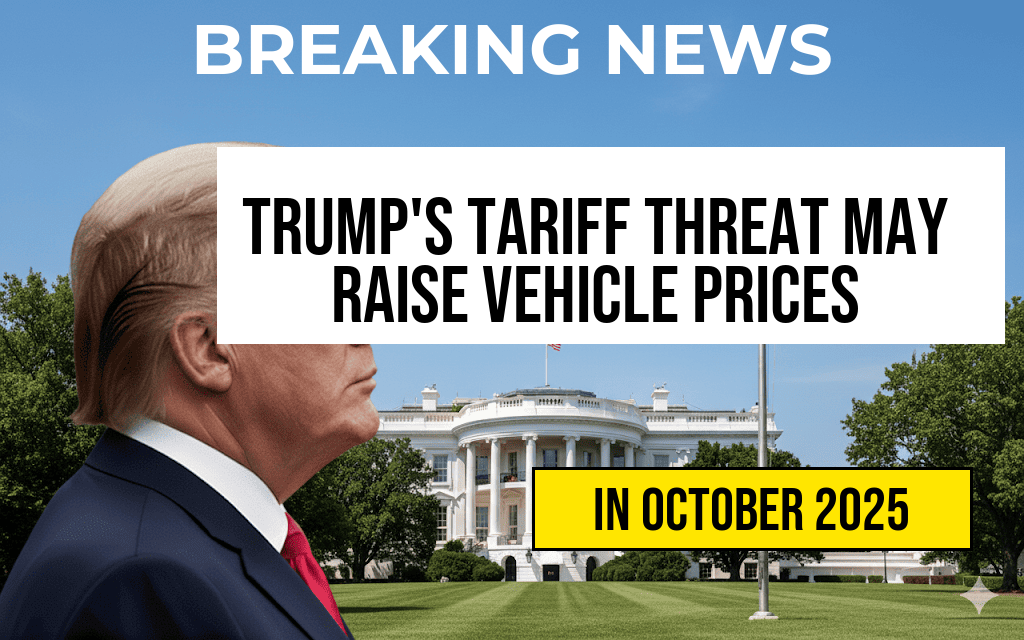Former President Donald Trump’s recent announcement regarding proposed tariffs on imported vehicles could significantly impact the automotive market, potentially increasing vehicle prices by as much as $5,286. This development raises concerns among consumers and industry analysts alike, as higher costs could lead to a ripple effect throughout the economy. The tariffs, aimed at boosting domestic manufacturing, have sparked debates about their implications for consumers, manufacturers, and the broader auto industry. As the automotive sector grapples with ongoing supply chain challenges and inflationary pressures, the proposed tariffs add another layer of complexity to an already turbulent landscape.
Understanding the Proposed Tariffs
The tariffs suggested by Trump, which could reach as high as 25% on certain imported vehicles, are part of a broader strategy to incentivize American manufacturing. This move is positioned as a way to bolster domestic production and protect American jobs. However, the implications for consumers could be profound, particularly in a market already characterized by rising prices and limited inventory.
Potential Impact on Vehicle Prices
Industry experts predict that the implementation of these tariffs could lead to substantial price increases across various vehicle segments. According to a report from the Forbes, the average cost increase per vehicle could range from $1,000 to over $5,000, depending on the make and model. This escalation could further strain consumer budgets and reduce the accessibility of vehicles.
Factors Contributing to Price Increases
A variety of factors contribute to the potential price hikes resulting from the proposed tariffs:
- Supply Chain Disruptions: The automotive industry has been grappling with ongoing supply chain issues, particularly related to semiconductor shortages, which have already driven up vehicle costs.
- Inflation: General inflationary pressures have been affecting consumer goods and services, making it increasingly difficult for consumers to afford new vehicles.
- Market Demand: With demand for vehicles remaining high, manufacturers may find it easier to pass along tariff-related costs to consumers.
Industry Response
Automakers and industry associations have expressed concerns regarding the proposed tariffs, arguing that they could stifle innovation and competitiveness in the automotive market. The Automotive News reported that many manufacturers are already facing challenges in adjusting to a rapidly changing market, and new tariffs could exacerbate these issues.
Concerns from Consumers
For consumers, the prospect of increased vehicle prices raises questions about affordability and accessibility. Many buyers may be forced to reconsider their purchasing decisions, leading to a potential decline in new vehicle sales. This trend could have long-term implications for the automotive sector, particularly as electric and hybrid vehicles gain traction.
The Broader Economic Implications
The proposed tariffs could extend beyond the automotive industry, impacting related sectors such as manufacturing, retail, and logistics. Economic analysts warn that higher vehicle prices could lead to decreased consumer spending, affecting overall economic growth. Additionally, the potential for retaliatory tariffs from other countries could escalate into a trade war, further complicating the situation.
Consumer Strategies
In light of these developments, consumers may want to consider various strategies to mitigate the impact of rising vehicle prices:
- Explore Used Vehicles: With new vehicle prices on the rise, consumers may find better value in the used car market.
- Consider Alternative Financing: Exploring different financing options could help manage monthly payments despite higher vehicle costs.
- Stay Informed: Keeping abreast of market trends and pricing can help consumers make informed decisions about their purchases.
Conclusion
As the automotive industry braces for the potential impact of Trump’s tariff proposals, consumers and manufacturers alike are left to navigate an uncertain landscape. With vehicle prices potentially spiking and economic implications looming, the coming months will be crucial for assessing the true effects of these tariffs on the market.
Frequently Asked Questions
What impact could Trump’s tariff threat have on vehicle prices?
The tariff threat from Trump could potentially increase vehicle prices by as much as $5,286, affecting consumers and the automotive industry.
Which vehicles are likely to be most affected by the tariffs?
The tariffs are expected to impact a wide range of vehicles, particularly those imported from countries with high trade volumes, such as China and Mexico.
How do tariffs affect the cost of vehicles?
Tariffs impose additional costs on imported goods, which can lead manufacturers to raise prices for consumers to maintain profit margins.
What are the potential consequences for the automotive industry?
The automotive industry may face decreased sales due to higher vehicle prices, leading to potential job losses and reduced investments in production.
Is there any way consumers can mitigate the impact of rising vehicle prices due to tariffs?
Consumers might consider purchasing domestically produced vehicles, exploring financing options, or waiting for market adjustments to minimize the impact of rising prices.

Leave a Reply